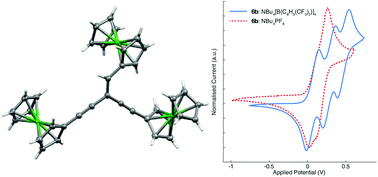Sandwich and half-sandwich metal complexes derived from cross-conjugated 3-methylene-penta-1,4-diynes†
Abstract
The cross-conjugated ethynyl–vinylidene [Ph2C![[double bond, length as m-dash]](https://www.rsc.org/images/entities/char_e001.gif) C(C
C(C![[triple bond, length as m-dash]](https://www.rsc.org/images/entities/char_e002.gif) CH){C(H)
CH){C(H)![[double bond, length as m-dash]](https://www.rsc.org/images/entities/char_e001.gif) CRu(PPh3)2Cp}]PF6 ([4a]PF6), and [FcC(H)
CRu(PPh3)2Cp}]PF6 ([4a]PF6), and [FcC(H)![[double bond, length as m-dash]](https://www.rsc.org/images/entities/char_e001.gif) C(C
C(C![[triple bond, length as m-dash]](https://www.rsc.org/images/entities/char_e002.gif) CH){C(H)
CH){C(H)![[double bond, length as m-dash]](https://www.rsc.org/images/entities/char_e001.gif) CRu(PPh3)2Cp}]PF6 ([4b]PF6), and ethynyl–alkynyl Ph2C
CRu(PPh3)2Cp}]PF6 ([4b]PF6), and ethynyl–alkynyl Ph2C![[double bond, length as m-dash]](https://www.rsc.org/images/entities/char_e001.gif) C(C
C(C![[triple bond, length as m-dash]](https://www.rsc.org/images/entities/char_e002.gif) CH){C
CH){C![[triple bond, length as m-dash]](https://www.rsc.org/images/entities/char_e002.gif) CRu(PPh3)2Cp} (5a), and FcC(H)
CRu(PPh3)2Cp} (5a), and FcC(H)![[double bond, length as m-dash]](https://www.rsc.org/images/entities/char_e001.gif) C(C
C(C![[triple bond, length as m-dash]](https://www.rsc.org/images/entities/char_e002.gif) CH){C
CH){C![[triple bond, length as m-dash]](https://www.rsc.org/images/entities/char_e002.gif) CRu(PPh3)2Cp} (5b) compounds (Cp = η5-cyclopentadienyl) have been prepared from reactions of the known 3-methylene-penta-1,4-diynes Ph2C
CRu(PPh3)2Cp} (5b) compounds (Cp = η5-cyclopentadienyl) have been prepared from reactions of the known 3-methylene-penta-1,4-diynes Ph2C![[double bond, length as m-dash]](https://www.rsc.org/images/entities/char_e001.gif) C(C
C(C![[triple bond, length as m-dash]](https://www.rsc.org/images/entities/char_e002.gif) CH)2 (3a) and [FcCH
CH)2 (3a) and [FcCH![[double bond, length as m-dash]](https://www.rsc.org/images/entities/char_e001.gif) C(C
C(C![[triple bond, length as m-dash]](https://www.rsc.org/images/entities/char_e002.gif) CH)2] (3b) with [RuCl(PPh3)2Cp]. The compounds derived from 3b incorporating the more electron-rich alkene proved to be unstable during work-up, and attempts to prepare bis(ruthenium) complexes from 3a and 3b or from transmetallation reactions of the bis(alkynylgold) complex FcCH
CH)2] (3b) with [RuCl(PPh3)2Cp]. The compounds derived from 3b incorporating the more electron-rich alkene proved to be unstable during work-up, and attempts to prepare bis(ruthenium) complexes from 3a and 3b or from transmetallation reactions of the bis(alkynylgold) complex FcCH![[double bond, length as m-dash]](https://www.rsc.org/images/entities/char_e001.gif) C(C
C(C![[triple bond, length as m-dash]](https://www.rsc.org/images/entities/char_e002.gif) CAuPPh3)2 (7) with RuCl(PPh3)2Cp were unsuccessful. The related bis- and tris(ferrocenyl) derivatives Ph2C
CAuPPh3)2 (7) with RuCl(PPh3)2Cp were unsuccessful. The related bis- and tris(ferrocenyl) derivatives Ph2C![[double bond, length as m-dash]](https://www.rsc.org/images/entities/char_e001.gif) C(C
C(C![[triple bond, length as m-dash]](https://www.rsc.org/images/entities/char_e002.gif) CFc)2 (6a) and FcCH
CFc)2 (6a) and FcCH![[double bond, length as m-dash]](https://www.rsc.org/images/entities/char_e001.gif) C(C
C(C![[triple bond, length as m-dash]](https://www.rsc.org/images/entities/char_e002.gif) CFc)2 (6b) were more readily obtained from Pd(II)/Cu(I) catalysed cross-coupling reactions of FcC
CFc)2 (6b) were more readily obtained from Pd(II)/Cu(I) catalysed cross-coupling reactions of FcC![[triple bond, length as m-dash]](https://www.rsc.org/images/entities/char_e002.gif) CH with the 1,1-dibromo vinyl complexes PhC
CH with the 1,1-dibromo vinyl complexes PhC![[double bond, length as m-dash]](https://www.rsc.org/images/entities/char_e001.gif) CBr2 (1a) and FcC(H)
CBr2 (1a) and FcC(H)![[double bond, length as m-dash]](https://www.rsc.org/images/entities/char_e001.gif) CBr2 (1b). Cyclic voltammetry of 6a and 6b using n-Bu4N[PF6] as the supporting electrolyte shows broad, overlapping waves arising from the sequential oxidation of the ferrocenyl moieties in electronically and chemically similar environments. Electrostatic effects between the ferrocenyl moieties are enhanced in solutions of the weakly ion-pairing electrolyte n-Bu4N[B{C6H3(CF3)2-3,5}4], leading to better resolution of the individual electrochemical processes. The comparative IR spectroelectrochemical response of 6a and 6b suggest the vinyl ferrocene moiety in 6b undergoes oxidation before the ethynyl ferrocene fragments. There is no evidence of electronic coupling between the metallocene moieties and [6a]+, [6b]n+ (n = 1, 2) are best described as Class I mixed-valence compounds.
CBr2 (1b). Cyclic voltammetry of 6a and 6b using n-Bu4N[PF6] as the supporting electrolyte shows broad, overlapping waves arising from the sequential oxidation of the ferrocenyl moieties in electronically and chemically similar environments. Electrostatic effects between the ferrocenyl moieties are enhanced in solutions of the weakly ion-pairing electrolyte n-Bu4N[B{C6H3(CF3)2-3,5}4], leading to better resolution of the individual electrochemical processes. The comparative IR spectroelectrochemical response of 6a and 6b suggest the vinyl ferrocene moiety in 6b undergoes oxidation before the ethynyl ferrocene fragments. There is no evidence of electronic coupling between the metallocene moieties and [6a]+, [6b]n+ (n = 1, 2) are best described as Class I mixed-valence compounds.

- This article is part of the themed collection: Multimetallic complexes: synthesis and applications


 Please wait while we load your content...
Please wait while we load your content...